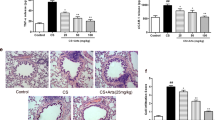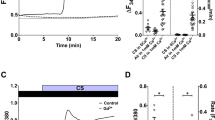Summary
To investigate the effect of cigarette smoke extract (CSE) on the role of protein kinase C (PKC) in the proliferation of passively sensitized human airway smooth muscle cells (HASMCs). After synchronization of cultured HASMCs, they were divided into a group A and Group B. The group A was treated with normal human serum and served as controls and the group B was treated with the serum of asthma patients. The group A was further divided into group of A1, A2 and A3 and the group B was sub-divided into the group of B1, B2, B3, B4 and B5. No other agents were added to the group A1 and B1. The cells of group A2 and B2 were stimulated with 5 % CSE for 24 h. HASMCs from group A3 and B3 were treated with PKC agonist PMA (10 nmol/L) and CSE (5 %) for 24 h. PKC inhibitor Ro-31-8220 (5 μmol/L) was added to the HASMCs of group B4 for 24 h. The cells from group B5 were stimulated with Ro-31-8220 (5 μmol/L) and CSE (5 %) for 24 h. The proliferation of HASMCs isolated from group A and B was examined by cell cycle analysis, MTT colorimetric assay and3H-TdR incorporation test. The expression of PKC-α in each group was observed by Western blotting and RT-PCR, respectively. The results showed that the percentage of S phase, absorbance (A) value, the rate of3H-TdR incorporation, the ratios ofA value of PKC-α mRNA and theA value of PKC-α protein in HASMCs from group B1, B2 and B3 were significantly increased compared to those of group A1, A2 and A3 correspondingly and respectively (P<0.01). The proliferation of HASMCs of group A2 and B2 stimulated with CSE and group A3 and B3 stimulated with CSE and PMA were also significantly enhanced when group A1, A2 and A3 and group B1, B2 and B3 compared to each other (P<0.05,P<0.01, respectively). The percentage of S phase, absorbency (A) value,3H-TdR incorporation rate, the ratios ofA value of PKC-α mRNA and theA value of PKC-α protein in HASMCs from group B4 treated with Ro-31-8220 and group B5 treated with CSE and Ro-31-8220 were significantly decreased as compared to those of group B1 and B2 correspondingly and respectively (P<0.05,P<0.01). It was concluded that CSE can enhance the passively sensitized HASMC proliferation and the expression of PKC alpha. PKC and its alpha subtype may contribute to this process. Our results suggest cigarette may play an important role in ASMCs proliferation of asthma through PKC signal pathway.
Similar content being viewed by others
References
Eisner M D, Blance P D. Environmental tobacco smoke exposure during travel among adults with asthma. Chest, 2002, 122(3): 826
Wu Z X, Zhou D, Chen Get al. Airway hyperresponsiveness to cigarette smoke in ovalbumin-sensitized guinea pigs. Am J Respir Crit Care Med, 2000, 161 (1): 73
Wyatt T A, Heires A J, Sanderson S Det al. Protein kinase C activation is required for cigarette smoke-enhanced C5a-mediated release of interleukin-8 in human bronchial epithelial cells. Am J Respir Cell Mol Biol, 1999, 21(2):283
Johnson P R A, Black J L, Carlin Set al. The production of extracellular matrix proteins by human passively sensitized airway smooth-muscle cells in culture: the effect of beclomethasone. Am J Respir Crit Care Med, 2000, 162(6): 2145
Vayssier-Taussat M, Camilli T, Aron Yet al. Effects of tobacco smoke and benzo [a] pyrene on human endothelial cells and monocyte stress responses. Am J Physiol Heart Circ Physiol, 2001, 280(3): H1293
Roskoski R. Assays of protein kinase. Methods Enzymol, 1983, 99: 3
Webb B L, Lindsay M A, Seybold Jet al. Identification of the protein kinase C isoenzymes in human lung and airways smooth muscle at the protein and mRNA level. Biochem Pharmacol, 1997, 54: 199
Stephen I R. Cigarette smoke in research. Am J Respir Cell Mol Biol, 2004, 31(5): 479
Cook D G, Strachan D P. Health effects of passive smoking in parental smoking and prevalence of respiratory symptoms and asthma in school age children. Thorax, 1997, 52(12): 1081
Xu S Y, Xu Y J, Zhang Z Xet al. Contribution of protein kinase C to passively sensitized human airway smooth muscle cells proliferation. Chin Med J, 2004, 117(1): 30
Author information
Authors and Affiliations
Additional information
LIN Junling, male, born in 1969, M. D., Ph.D.
Rights and permissions
About this article
Cite this article
Junling, L., Yongjian, X., Zhenxiang, Z. et al. Effect of cigarette smoke extract on the role of protein kinase C in the proliferation of passively sensitized human airway smooth muscle cells. Current Medical Science 25, 269–273 (2005). https://doi.org/10.1007/BF02828139
Received:
Published:
Issue Date:
DOI: https://doi.org/10.1007/BF02828139




